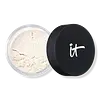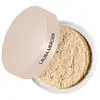IT Cosmetics Bye Bye Pores Translucent Loose Setting Powder Versus Laura Mercier Ultra Blur Translucent Lose Setting Powder
What's inside
What's inside
 Key Ingredients
Key Ingredients

 Benefits
Benefits

 Concerns
Concerns

 Ingredients Side-by-side
Ingredients Side-by-side

Silica
AbrasiveSoluble Collagen
HumectantMagnesium Ascorbyl Phosphate
AntioxidantTocopheryl Acetate
AntioxidantHydrolyzed Silk
HumectantAloe Barbadensis Leaf Juice
Skin ConditioningHydrolyzed Collagen
EmollientNiacinamide
SmoothingAscorbyl Palmitate
AntioxidantWater
Skin ConditioningAlgae Extract
EmollientAvena Sativa Kernel Extract
AbrasiveButylene Glycol
HumectantCamellia Sinensis Leaf Extract
AntimicrobialCarbomer
Emulsion StabilisingCholesteryl Chloride
Skin ConditioningCholesteryl Nonanoate
EmollientCholesteryl Oleyl Carbonate
Skin ConditioningCitric Acid
BufferingGlycerin
HumectantGlycyrrhiza Glabra Root Extract
BleachingHelianthus Annuus Seed Oil
EmollientOlea Europaea Leaf Extract
PerfumingPalmitoyl Oligopeptide
CleansingPalmitoyl Tetrapeptide-7
Skin ConditioningPhenoxyethanol
PreservativePolysorbate 20
EmulsifyingPotassium Sorbate
PreservativeRetinyl Palmitate
Skin ConditioningRosa Canina Flower Extract
AstringentSodium Benzoate
MaskingSodium Hyaluronate
HumectantTocopherol
AntioxidantVitis Vinifera Seed Extract
AntimicrobialCI 77891
Cosmetic ColorantIron Oxides
Silica, Soluble Collagen, Magnesium Ascorbyl Phosphate, Tocopheryl Acetate, Hydrolyzed Silk, Aloe Barbadensis Leaf Juice, Hydrolyzed Collagen, Niacinamide, Ascorbyl Palmitate, Water, Algae Extract, Avena Sativa Kernel Extract, Butylene Glycol, Camellia Sinensis Leaf Extract, Carbomer, Cholesteryl Chloride, Cholesteryl Nonanoate, Cholesteryl Oleyl Carbonate, Citric Acid, Glycerin, Glycyrrhiza Glabra Root Extract, Helianthus Annuus Seed Oil, Olea Europaea Leaf Extract, Palmitoyl Oligopeptide, Palmitoyl Tetrapeptide-7, Phenoxyethanol, Polysorbate 20, Potassium Sorbate, Retinyl Palmitate, Rosa Canina Flower Extract, Sodium Benzoate, Sodium Hyaluronate, Tocopherol, Vitis Vinifera Seed Extract, CI 77891, Iron Oxides
Mica
Cosmetic ColorantLauroyl Lysine
Skin ConditioningZinc Stearate
Cosmetic ColorantAluminum Starch Octenylsuccinate
AbsorbentSilica
AbrasiveC13-15 Alkane
SolventEthylhexylglycerin
Skin ConditioningHelianthus Annuus Seed Oil
EmollientTocopherol
AntioxidantSodium Hyaluronate
HumectantSorbic Acid
PreservativeBlue 1 Lake
Cosmetic ColorantIron Oxides
CI 77742
Cosmetic ColorantCI 15850
Cosmetic ColorantCI 77891
Cosmetic ColorantCI 77007
Cosmetic ColorantCI 19140
Cosmetic Colorant
 Reviews
Reviews

Ingredients Explained
These ingredients are found in both products.
Ingredients higher up in an ingredient list are typically present in a larger amount.
Ci 77891 is a white pigment from Titanium dioxide. It is naturally found in minerals such as rutile and ilmenite.
It's main function is to add a white color to cosmetics. It can also be mixed with other colors to create different shades.
Ci 77891 is commonly found in sunscreens due to its ability to block UV rays.
Learn more about CI 77891Helianthus Annuus Seed Oil is the oil derived from the seeds of a Sunflower. Sunflower seed oil is non-fragrant. It is an emollient, meaning it helps to soften the skin.
Sunflower seed oil contains many fatty acids. The fatty acids found in sunflower seeds include (from highest amount to least): linoleic acid, myristic acid, palmitic acid, stearic acid, arachidic acid, oleic acid, and linolenic acid.
These fatty acids help the skin create ceramides. Ceramides play a role in repairing the skin barrier.
Helianthus Annuus Seed Oil helps moisturize the skin. This in turn helps the skin look more rejuvenated and smoother.
Sunflowers are rich in vitamin E.
Historians believe Indigenous cultures of North America domesticated sunflowers before corn. Thus they relied on sunflower oil for a variety of uses. One such use is moisturizing skin and hair.
Sunflower seed oil may not be fungal acne safe. We recommend speaking with a professional if you have any concerns.
Learn more about Helianthus Annuus Seed OilSilica, also known as silicon dioxide, is a naturally occurring mineral. It is used as a fine, spherical, and porous powder in cosmetics.
Though it has exfoliant properties, the function of silica varies depending on the product.
The unique structure of silica enhances the spreadability and adds smoothness, making it a great texture enhancer.
It is also used as an active carrier, emulsifier, and mattifier due to its ability to absorb excess oil.
In some products, tiny microneedles called spicules are made from silica or hydrolyzed sponge. When you rub them in, they lightly polish away dead skin layers and enhance the penetration of active ingredients.
Learn more about SilicaSodium Hyaluronate is hyaluronic acid's salt form. It is commonly derived from the sodium salt of hyaluronic acid.
Like hyaluronic acid, it is great at holding water and acts as a humectant. This makes it a great skin hydrating ingredient.
Sodium Hyaluronate is naturally occurring in our bodies and is mostly found in eye fluid and joints.
These are some other common types of Hyaluronic Acid:
Learn more about Sodium HyaluronateTocopherol (also known as Vitamin E) is a common antioxidant used to help protect the skin from free-radicals and strengthen the skin barrier. It's also fat soluble - this means our skin is great at absorbing it.
Vitamin E also helps keep your natural skin lipids healthy. Your lipid skin barrier naturally consists of lipids, ceramides, and fatty acids. Vitamin E offers extra protection for your skin’s lipid barrier, keeping your skin healthy and nourished.
Another benefit is a bit of UV protection. Vitamin E helps reduce the damage caused by UVB rays. (It should not replace your sunscreen). Combining it with Vitamin C can decrease sunburned cells and hyperpigmentation after UV exposure.
You might have noticed Vitamin E + C often paired together. This is because it is great at stabilizing Vitamin C. Using the two together helps increase the effectiveness of both ingredients.
There are often claims that Vitamin E can reduce/prevent scarring, but these claims haven't been confirmed by scientific research.
Learn more about TocopherolThis ingredient is a combination of red, black, and yellow iron oxide pigments. This combination of colors is usually found in foundation, because it results in a "skin" color.